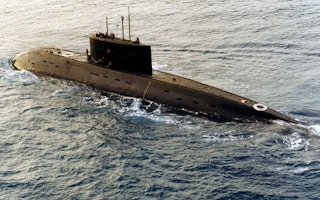Climate change and nuclear threats are closely linked and must be tackled together, US experts say.
The warning comes from a working group chaired by the Center for Climate and Security (CCS), a non-partisan policy institute of security and military experts (many of them high-ranking former members of the armed forces), in a reportwhich offers a framework for understanding and addressing the distinct problems together.
The report is published as this year’s UN climate summit draws to a close in Bonn in the aftermath of President Trump’s tour of Asia, during which nuclear weapons issues featured prominently.
Professor Christine Parthemore, a former adviser to the US defence department, co-chairs the working group. She told the Climate News Network:
“Simultaneous effects of climate change, tough social or economic pressures, and security challenges could increase the risk of conflict among nuclear weapon-possessing states, even if that conflict stems from miscalculation or misperception. India and Pakistan are major concerns.
“They are grappling with water stress, deadly natural disasters, terrorism, and numerous other pressures. At the same time, the types of nuclear weapons they are developing and policies on command of those weapons are raising tensions between them.
“Our group believed this is a recipe for not only increasing the risk of conflict, but for raising the risk of such a conflict escalating to the nuclear realm.
“Big picture: nuclear nonproliferation regimes and international climate change cooperation help underpin the global order. They are stabilising forces, and if we don’t continue strengthening them, we may see a less predictable global security environment.
“This is especially dangerous in times like these when some countries are more actively flaunting their nuclear threats toward one another. North Korea has been the most active in that regard.”
The authors say countries such as Nigeria, Jordan, Egypt and Saudi Arabia are dealing simultaneously with a range of interdependent internal pressures – including climatic, economic, security, and environmental demands – as they pursue nuclear energy.
“
Simultaneous effects of climate change, tough social or economic pressures, and security challenges could increase the risk of conflict among nuclear weapon-possessing states, even if that conflict stems from miscalculation or misperception.
Christine Parthemore, co-chairperson, Center for Climate and Security
Reactor safety
Bangladesh is coping with sea-level rise and changing Himalayan glacial patterns, and with terrorism and overpopulation. The report says these stresses could affect the security and safety of the nuclear reactors being built in the country with Russian help.
It says extreme heat, flooding, sea level rise and natural disasters are already affecting power stations and could knock out nuclear installations in countries already short of electricity and facing social or political pressure.
The same dilemmas could face sites handling nuclear weapons.
Concerns about nuclear security and proliferation could help countries to rely instead on fossil fuels and maintain their high dependence on them, “making dangerous, business-as-usual climate change scenarios more likely”.
And it says people forced into migration by climate change or other factors can affect security and nuclear stability.
The report says it is important to develop technologies to help countries which seek to introduce nuclear energy, including the safest reactor designs, modern security and monitoring systems and strong climate modelling abilities.
New risks
It says this is especially critical in the potential crisis regions where combining security, climate, and nuclear risks must be addressed urgently: South Asia, the Middle East, the South China Sea and Central and North Africa.
The report also says there is mounting evidence that various security challenges, climatic trends and nuclear issues are combining in new and potentially high-risk ways.
Mapping and addressing this complexity is critical for protecting US security interests not only in these crisis regions, but across the Indo-Asia-Pacific and Europe as well.
It urges the US to develop realistic planning, better communication about nuclear and climate risks, and education for policymakers about practical ways they can protect America’s capacities for coping with these challenges.
The report suggests that US leaders should encourage more robust engagement between public and policymakers on risks like nuclear conflict and climate change, and should convey risks in ways that people can relate to, for example emphasising ways to reduce threats to vulnerable infrastructure.
This story was published with permission from Climate News Network.

















